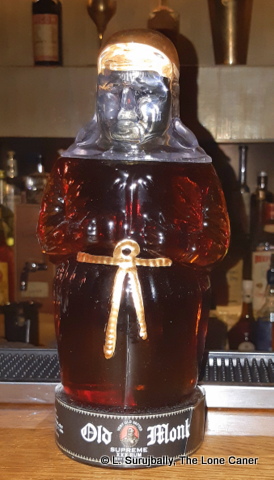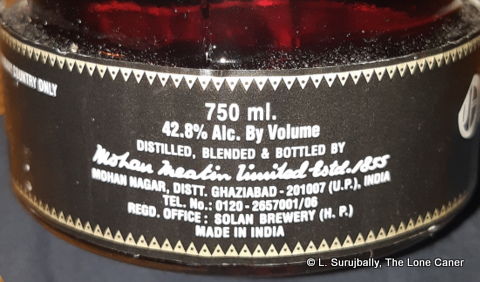 The Old Monk series of rums, perhaps among the best known to the Western world of those hailing from India, excites a raft of passionate posts whenever it comes up for mention, ranging from enthusiastic fanboy positivity, to disdain spread equally between its lack of disclosure about provenance and make, and the rather unique taste. Neither really holds water, but it is emblematic of both the unstinting praise of adherents who “just like rum” without thinking further, and those who take no cognizance of cultures other than their own and the different tastes that attend to them.
The Old Monk series of rums, perhaps among the best known to the Western world of those hailing from India, excites a raft of passionate posts whenever it comes up for mention, ranging from enthusiastic fanboy positivity, to disdain spread equally between its lack of disclosure about provenance and make, and the rather unique taste. Neither really holds water, but it is emblematic of both the unstinting praise of adherents who “just like rum” without thinking further, and those who take no cognizance of cultures other than their own and the different tastes that attend to them.
That’s unfortunate — because we should pay attention to other countries’ rums. As I remarked in a rambling interview in early July 2020, concentration on the “Caribbean 5” makes one ignore other parts of the world far too often, and make no mistake, rum really is a global spirit, often indigenously so, in a way whisky or gin or vodka are not. One of the things I really enjoy about it is its immense variety, which the Old Monk, Dzama, Batavia Arrack, Bundaberg , Mhoba, Cor Cor, Juan Santos and Bacardi (to list just a few examples from around the world) showcase every bit as well as the latest drooled-over Hampden or Foursquare.
Which is not to say, I’m afraid, that this rum from India deserves unstinting and uncritical accolades as some sort of natural backcountry traditional spirit made in The Old Way for generations. To begin with, far too little is known about it. Leaving aside the very interesting history of the Indian company Mohan Meakin, official blurbs talk about it being made in the “traditional manner” and then never say what that actually is. No production details are provided, either on the bottle or the company website – but given its wild popularity in India and the diaspora, and its massive sales numbers even in a time of demise (2016 – ~4 million cases) it suggests something made on a large scale, with an ageing process in place. Is it truly a blend of various 12 year old rums, as some sources suggest? No way of knowing, but at the price point it sells for, it strikes me as unlikely. Beyond that and the strength (42.8% ABV), we have nothing.
That means we take the rum as it is almost without preconceptions, and indeed, the initial notes of the smell are promising: it’s thick and solid, redolent of boiled sweets, caramel bon bons, crushed walnuts, bitter cocoa, coffee grounds, ashes, molasses, brine, even some olives. But it’s too much of the sweet, and it smells – I’m choosing this word carefully – cloying. There is just too much thickness here, it’s a morass of bad bananas, sweet molasses and brown sugar rotting in the sun, and reminds me of nothing so much as jaggery, such as that which I recall with similar lack of fondness from the Amrut Two Indies. But as a concession there was a bit of brine and clear cane juice, just insufficient to enthuse.
The sensation of thickness and dampening was much more pronounced on the palate, and I think this is where people’s opinions start to diverge. There’s a heavy and furry softness of texture on the mouthfeel, tastes of molasses, coffee, cocoa, with too much brown sugar and wet jaggery; it reminds me of a hot toddy, and I don’t say that with enthusiasm. It’s a cocktail ready-made and ready to drink, good for a cold day and even a citrus hint (which rescues it from being a completely cloying mess) doesn’t do enough to rescue it from the bottom of the glass. And the finish, well, noting to be surprised at – it’s short, it’s sweet, it’s thick, and it’s thankfully over very quickly.

I can’t rid myself of the feeling something has been added here. Sugar, caramel, spices, I don’t know. Wes at the FRP did the hydrometer test on it and it came up clean, yet you can’t taste this thing and tell me it’s as pure as Caesar’s Jamaican wife, not even close. In point of fact, though, what this rum reminds me of is its cousin the Amrut Two Indies, the Nepalese Kukhri (though not as sweet), a low-end Jamaican Rum (Myer’s, Appleton V/X maybe, or even a less interesting el Dorado 12 Year Old. Because of the profile I describe, it can certainly be had by itself or mixed into a sugar-free cola very nicely and therein lies, I suspect, much of its appeal as a spirit in Asia.
In Asia maybe – but not in Europe. The bartender at the Immertreu Bar in Berlin showed some surprise when I selected it from his back shelf, and shook his head with evident disappointment. “For this, you don’t need a tasting glass” he sniffed, not even bothering to hide his disdain. And after I had smelled, tasted and tried it, then looked askance at the glass, he shrugged…”I told you so.” He didn’t understand that had to try the rum whether or not I believed him, but to be honest, this was one of those occasions where I wish I had listened harder. Back in the 1970s and 1980s Old Monk may have outsold all other brands in India, and ten years later could even price itself higher than Bacardi in Germany, and outsell it….but those glory days, I’m afraid, are gone. The world has moved on. Old Monk hasn’t, and that’s both its attraction and its downfall to those who try it for the first time, and go on to either love it or hate it. Few of these, however, will remain completely indifferent.
(#745)(79/100)
Other Notes
- I am assuming a column still product derived from molasses or jaggery. Online background suggests it is a blend of 12 year old rums, but the official website makes no such claim and neither does the label, so I’ll leave it as a blended aged rum without further elaboration.
- Whether it was distilled past 90% or taken off the still before that is equally unknown. The cynic in me suggests it might be flavoured ethanol, not just because of the taste, but also since the company never actually says anything about the production process and this invites both suspicion and censure in this day and age.
- The bottle shape is not all glass – from the shoulders up it is plastic.
- Who the figure of the monk represents is unclear. One possibly apocryphal story suggests there was a British monk who used to hang around the factory where Mohan Meakin’s rums were made and aged, shadowing the master blender – his advice was so good that when Old Monk was first launched the name and bottle were based on him. Another story goes it was the idea of one of the founders, Ved Mohan, who was inspired by the life of Benedictine monks. And a third variation is that it’s actually H.G. Meakin who took over the Dyer Brewery and distillery in 1887 and formed Dyer-Meakin.
- Wikipedia, the Times of India, Business Today and Mid-Day.com (an Indian online paper) say the brand was launched in 1954, and some European marketing material says 1935. I think 1954 is likely correct.
- The XXX in the title refers to “Very-Extra-Good-Something” and is not meant to be salacious.
- The bottle shape was unique enough for me to give it a mention in the disposable clickbait list of 12 Interesting Bottle Designs.
- A detailed biography of Mohan Meakin is available here.